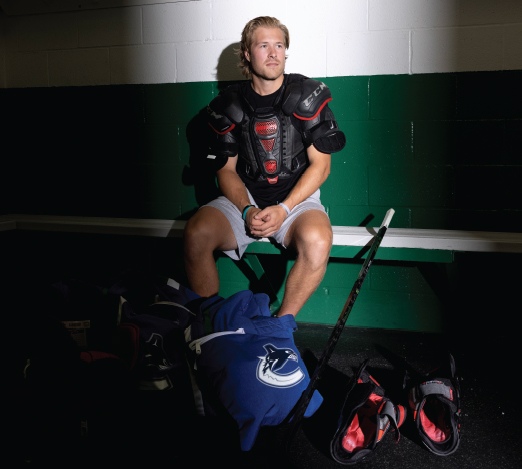Actions Speak Louder Than Words

By: Jessi Pierce, USA Hockey
There’s a stoic demeanour about Brock Boeser. A quiet approach to NHL stardom sprinkled in with a competitive drive and need-to-win vibe all rolled into one.
And while many NHL fans located outside of the Pacific Northwest time zone may not get to experience it on a regular basis, for those who have the opportunity to see him play night in and night out it’s a joy to watch.
“Brock’s an awesome dude,” said J.T. Miller, an Ohio native and Boeser’s Vancouver Canucks teammate. “He’s super laid back, very laid back, and easy to get along with.
“From the team standpoint, he’s part of our team, and when we have success, he’s normally a big reason behind that.”
Like many of us, Boeser’s character was shaped by his life circumstances and situations. A Burnsville, Minn., native, the 24-year-old has faced more adversity than most people twice his age. And still, he excels, using the game of hockey as an escape in situations that are hard to grasp.
“I think when you go through some tough situations, it makes you appreciate that you get to play a game more,” Boeser admitted. “I know for me anyway, that’s how I feel in some of my life situations.”
From the 2-year-old who carried a mini stick everywhere to an NHL superstar and 2022 U.S. Olympic hopeful, Boeser has used his hardships as building blocks, continuing to cement his place among the best forwards in the league.
Staying Humble
Almost every player harbours an NHL dream. Few make it a reality.
While Boeser is a part of the small margin that made it, it took him until his senior year of high school to see professional hockey as a possibility.
“My whole goal in the NHL Draft was to go in the top two or three rounds,” recalled Boeser, who led the United States Hockey League with 35 goals for the Waterloo Black Hawks ahead of his draft year in 2015.
“Then, all of a sudden, they started talking about the first round, and that was when I thought I might have a shot at this NHL-life thing.
“You always hear how hard it is to make it to the NHL, like only one percent out of college or whatever it is. I just didn’t think about it too much.”
Boeser was one of seven Americans who heard their names called in the first round of the 2015 NHL Draft when the Canucks selected him with the 23rd overall pick. He would go on to play two seasons at the University of North Dakota.
“He was selected in the first round, so people around him knew he was good, but so many, including himself, didn’t know how good,” said Derek Plante, who coached Boeser at the 2014 Ivan Hlinka Memorial Cup and watched him throughout his youth hockey career in Minnesota. “He’s a special kid, and a fun player to watch.”
Rattle off Boeser’s NHL stats and accomplishments to him-All-Star Game MVP, Calder Trophy finalist, 98 goals and 210 points in 253 NHL games-and you’re met with a small smile and shake of the head.
“It’s pretty cool, but that’s not what it’s about,” he said. “We have yet to win the ultimate goal, the Stanley Cup, so until then, the rest is just building toward that.”
Significance Of The 6
Hockey players are identified by their numbers on the ice. Boeser’s No. 6 uniform identifies more than just himself. It represents a deep connection to those close to him.
First, there’s Boeser’s father, Duke, who wore No. 6 when he played hockey in high school.
In 2010, Duke was diagnosed with Parkinson’s Disease. In 2012, a car accident left him with a brain injury. Since 2017 he has been battling lung cancer, and in 2020 he suffered a massive heart attack where his heart stopped twice. Duke is back at the family’s Burnsville home with Boeser’s mom, Laurie, and a full-time caregiver.
“It’s tough. We started to notice more declines, and it’s been a slow process,” said Boeser, whose dad announced him as a starter for his NHL debut against the Minnesota Wild on March 25, 2017. He scored his first NHL goal in the same game, a 4-2 win.
“But seeing everything my dad’s gone through, I don’t know how someone can go through so much and still be trucking along and laughing and smiling. It’s just cool to see that. And my mom, everything she has to do taking care of him. It’s a lot. Not many people can do it, but she’s a really strong woman.”
No. 6 was also worn by Boeser’s childhood friend, Ty Aleya.
 On Aug. 6, 2014, days before Boeser was set to compete with the U.S. Under-18 Select Team at the Hlinka Memorial Cup half a world away in the Czech Republic, he was informed that Aleya had died in a rollover car accident. Boeser’s friend, Cole Borchardt, was also severely injured in the crash.
On Aug. 6, 2014, days before Boeser was set to compete with the U.S. Under-18 Select Team at the Hlinka Memorial Cup half a world away in the Czech Republic, he was informed that Aleya had died in a rollover car accident. Boeser’s friend, Cole Borchardt, was also severely injured in the crash.
“We chatted with him right away to see where he was at,” Plante recalled. “We talked to his mom to see what they wanted to do. I’m sure in some ways he was a bit in shock. There’s no handbook on how to handle that. We just tried to care for him, like we would do with any kid.
“He didn’t make it about him. From a hockey perspective, during the games, you’d never know. He was able to shut it off and play with a lot of emotion.”
“Honestly, I don’t really know how I did it still to this day,” Boeser said of competing, helping the U.S. to a third-place finish with six goals and eight points in five games. “I still don’t understand why I didn’t come home. I think I knew it was an important week and my family and friends told me to stay there and play. It’s still the toughest week of my life to this day. Being 16 and not having any of my close friends there or anything, it was tough. I don’t know how I did it but I just tried to take it a day at a time and focus on the hockey part.
“When I played those games, it helped me a lot. I think that’s why I had success there. You just stop thinking about everything that’s going on when you get on the ice. It made it that much easier to compete. We got bronze that tournament, so it was a good experience for the hockey part, but outside of that it wasn’t the greatest experience.”
The knobs of Boeser’s sticks read: 8.6.14 (the date of the accident), TA 6 (Ty Aleya, No. 6), CB 20 (Cole B, No. 20), TP 7 and MB 31 (the other two involved in the accident), along with Gma2 Gp2 6 with a cross for his grandparents and another 6 for Duke.
Yeah, Boeser identifies with No. 6 a lot.
“It’s nice to play for something and play with purpose,” he said.
Canucks Cadence
In five seasons, Boeser and the Canucks have only made the playoffs once. Injuries have riddled a team that has high expectations among the rabid fan base in this hockey-crazed province. Entering his sixth professional season, Boeser will be looked upon to carry even more of the team’s offensive load.
“He can change the course of the game. Not many players in the league can do that,” Miller said.
“He can score goals. He’s hard to play against. He has strength. He’s transitioning from that second, third, fourth year guy to a veteran player. It’s a big part of his career. It’s a very important time for him and I think he knows what he means to our team and our success.”
Boeser is aware of the outside pressures. He looks forward to deleting his Twitter handle at the start of each season, not to avoid the criticism, but to remain focused on the game that’s given him so much.
“There’s definitely pressure, always, but you just kind of have to put it to the side and control what you can control,” he said.
“I’ve taken that approach in hockey and life. I always say during the season to reporters, that I like to take things a day at a time, and I don’t like to look at past situations. I like to learn from them and move on, so that’s kind of how I handle that.”
Jessi Pierce is a freelance writer and podcast host covering the NHL in St. Paul, Minn. Follow her on Twitter at @jessi_pierce
